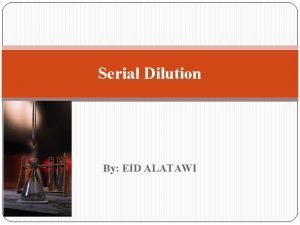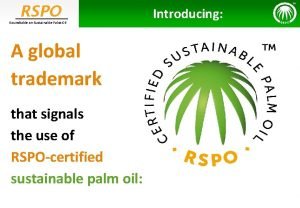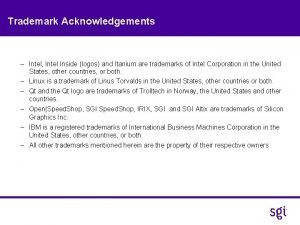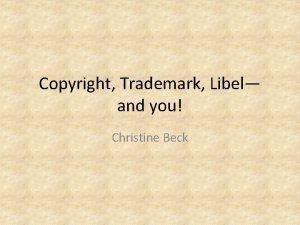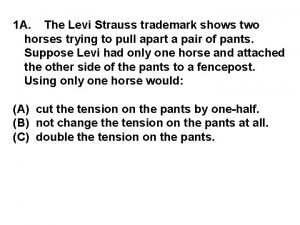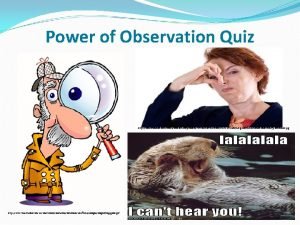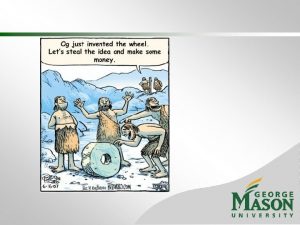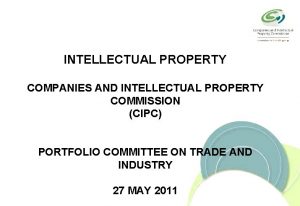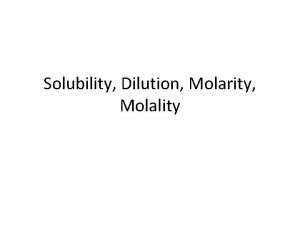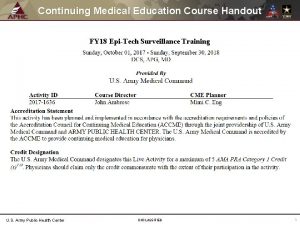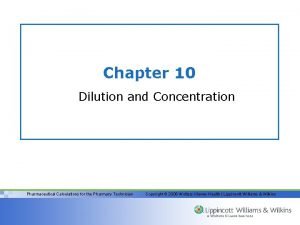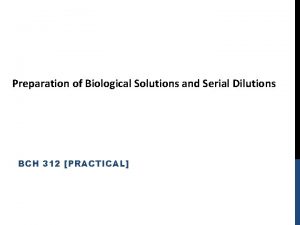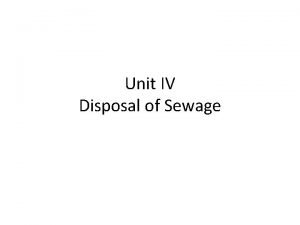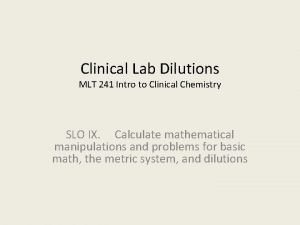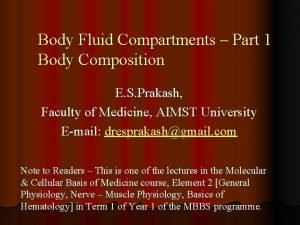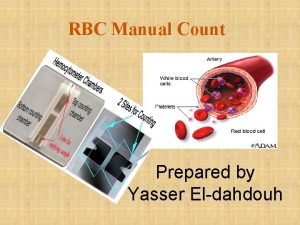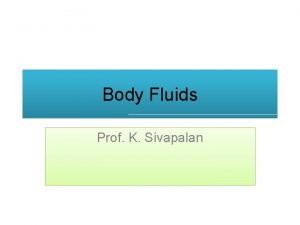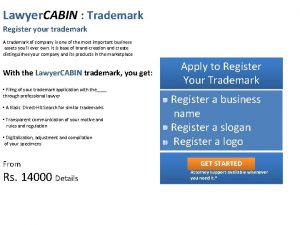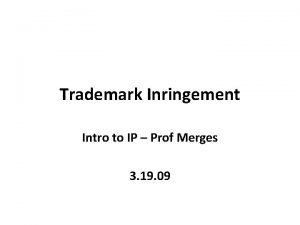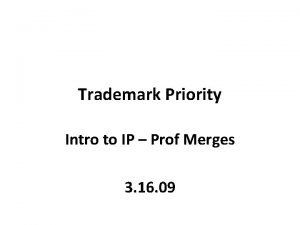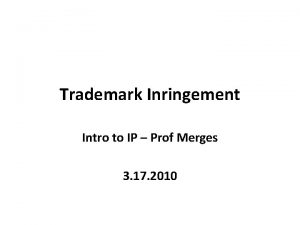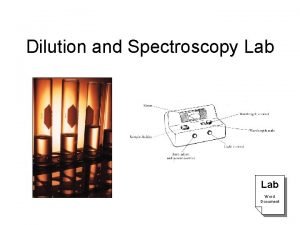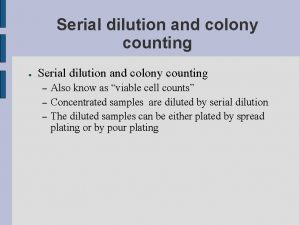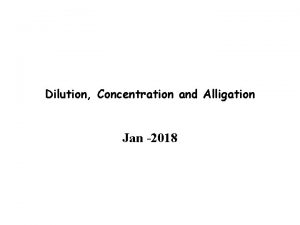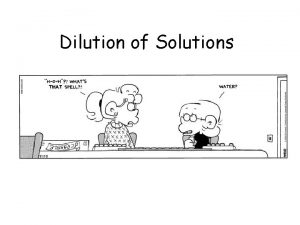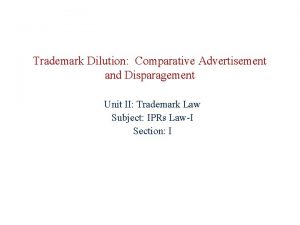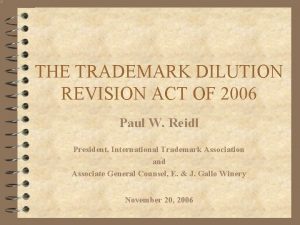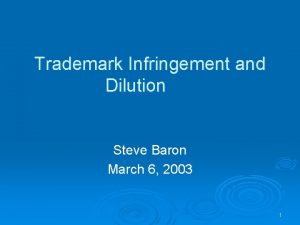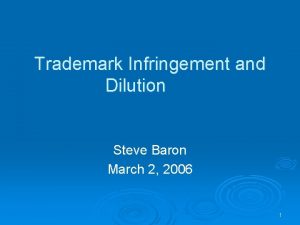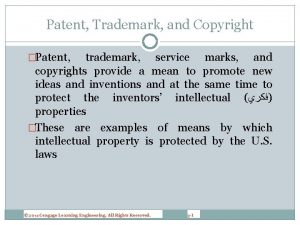Trademark Dilution Intro to IP Prof Merges 3






![Nature of dilution The bill [that became § 43(c)] defines the term ‘‘dilution’’ to Nature of dilution The bill [that became § 43(c)] defines the term ‘‘dilution’’ to](https://slidetodoc.com/presentation_image_h2/ca8235d2537dd787736f8fe225a93a09/image-7.jpg)










![Dilution/Parody “[T]he Second Circuit and its district courts have held on numerous occasions that Dilution/Parody “[T]he Second Circuit and its district courts have held on numerous occasions that](https://slidetodoc.com/presentation_image_h2/ca8235d2537dd787736f8fe225a93a09/image-18.jpg)














![[A] pet chew toy to imitate and suggest, but not use, the marks of [A] pet chew toy to imitate and suggest, but not use, the marks of](https://slidetodoc.com/presentation_image_h2/ca8235d2537dd787736f8fe225a93a09/image-33.jpg)











- Slides: 44

Trademark Dilution Intro to IP - Prof Merges 3. 2012

Mayo Collaborative Services v. Prometheus Labs. , Inc. (Supreme Court 2012), http: //www. supremecourt. gov /opinions/11 pdf/10 -1150. pdf

US Patent 6, 355, 623, claim 1: A method of optimizing therapeutic efficacy for treatment of an immune-mediated gastrointestinal disorder, comprising: (a) administering a drug to a subject having said disorder; and (b) determining the level of [drug metabolite] in said subject having said disorder, Wherein [low levels increase dosage] wherein [high levels lower dosage]

“The relation is a consequence of the ways in which thiopurine compounds are metabolized by the body—entirely natural processes. And so a patent that simply describes that relation sets forth a natural law. ” “Because methods for making such determinations [of drug levels] were well known in the art, this step simply tells doctors to engage in wellunderstood, routine, conventional activity previously engaged in by scientists in the field. Such activity is normally not sufficient to transform an unpatentable law of nature into a patent-eligible application of such a law.

Trademark Dilution • TM Infringement – Recap • Vuitton v. Haute Diggity Dog, Inc. • Overview of the statute

Infringement - Example • Odom’s Tennessee Pride v FF Acquisition Co. , No 2009 -1473 • Federal Circuit, March 19, 2010
![Nature of dilution The bill that became 43c defines the term dilution to Nature of dilution The bill [that became § 43(c)] defines the term ‘‘dilution’’ to](https://slidetodoc.com/presentation_image_h2/ca8235d2537dd787736f8fe225a93a09/image-7.jpg)
Nature of dilution The bill [that became § 43(c)] defines the term ‘‘dilution’’ to mean ‘‘the lessening of the capacity of a famous mark to identify and distinguish goods or services regardless of the presence or absence of (a) competition between the parties, or (b) likelihood of confusion, mistakes, or deception. ’’

History • Anti-dilution Act: 1996 • Moseley v. V Secret Catalogue, 537 U. S. 418 (2003) (required showing of actual harm from dilution – very hard to prove) • 2006 revisions to § 43(c)


Louis Vuitton: causes of action • TM infringement (likelihood of confusion – as to source/sponsorship) • Copyright infringement – bag shape/design; not logo • TM dilution


• HAUTE DIGGITY DOG is the brain puppy of Pamela Reeder and together with partner Victoria Dauernheim, Haute Diggity Dog has quickly grown from a fun idea to a successful line of popular parody dog toys, unique collars, carry bags, and must have dog accessories. • PAMELA REEDER is no stranger to growing a business. She learned the ropes while owning a successful bath and body retail store. She also owned and operated a freelance floral design business. Pamela lives with her two beloved dogs Biscuit and Rusty. • VICTORIA DAUERNHEIM was one of the pioneers at Fed. Ex and assisted the start-up company through its development years into becoming a billion dollar giant we know today. Victoria has a feisty Pomeranium named Fluffy.




TM Infringement • Good review of infringement factors • Marketing channels, price – Internet marketing -- ?

Parody and TM Infringement “The name “Chewy Vuiton” is, like “Timmy Holedigger, ” an obvious parody of a famous brand name. The fact that the real Vuitton name, marks, and dress are strong and recognizable makes it unlikely that a parody -- particularly one involving a pet chew toy and bed -- will be confused with the real product. ”
![DilutionParody The Second Circuit and its district courts have held on numerous occasions that Dilution/Parody “[T]he Second Circuit and its district courts have held on numerous occasions that](https://slidetodoc.com/presentation_image_h2/ca8235d2537dd787736f8fe225a93a09/image-18.jpg)
Dilution/Parody “[T]he Second Circuit and its district courts have held on numerous occasions that in the case of parody, “the use of famous marks in parodies causes no loss of distinctiveness, since the success of the use depends upon the continued association with the plaintiff. ”

“This Court finds that no reasonable trier of fact could conclude that Plaintiff's mark is diluted by blurring in this case, and summary judgment is appropriate. Accordingly, Defendants' motion for summary judgment will be granted for dilution by blurring. ”

Tarnishment “Tarnishment occurs when the plaintiff's trademark is likened to products of low quality, or is portrayed in a negative context. Deere & Co. v. MTD Prods. , 41 F. 3 d 39, 43 (2 d Cir. 1994). When the association is made through harmless or clean puns and parodies, however, tarnishment is unlikely. ”

43(c) Dilution by blurring; dilution by tarnishment (1) Injunctive relief Subject to the principles of equity, the owner of a famous mark that is distinctive, inherently or through acquired distinctiveness, shall be entitled to an injunction against another person who, at any time after the owner's mark has become famous, commences use of a mark or trade name in commerce that is likely to cause dilution by blurring or dilution by tarnishment of the famous mark, regardless of the presence or absence of actual or likely confusion, of competition, or of actual economic injury.

(2) Definitions (A) For purposes of paragraph (1), a mark is famous if it is widely recognized by the general consuming public of the United States as a designation of source of the goods or services of the mark's owner. In determining whether a mark possesses the requisite degree of recognition, the court may consider all relevant factors, including the following:

(i) The duration, extent, and geographic reach of advertising and publicity of the mark, whether advertised or publicized by the owner or third parties. (ii) The amount, volume, and geographic extent of sales of goods or services offered under the mark. (iii) The extent of actual recognition of the mark. (iv) Whether the mark was registered. . .

43(c)(2)(B) For purposes of paragraph (1), "dilution by blurring" is association arising from the similarity between a mark or trade name and a famous mark that impairs the distinctiveness of the famous mark. In determining whether a mark or trade name is likely to cause dilution by blurring, the court may consider all relevant factors, including the following:

(i) The degree of similarity between the mark or trade name and the famous mark. (ii) The degree of inherent or acquired distinctiveness of the famous mark. (iii) The extent to which the owner of the famous mark is engaging in substantially exclusive use of the mark. (iv) The degree of recognition of the famous mark. (v) Whether the user of the mark or trade name intended to create an association with the famous mark. (vi) Any actual association between the mark or trade name and the famous mark.

But a trial court must offer a sufficient indication of which factors it has found persuasive and explain why they are persuasive so that the court’s decision can be reviewed. The district court did not do this adequately in this case. Nonetheless, after we apply the factors as a matter of law, we reach the same conclusion reached by the district court. – IPNTA 5 th at 845.

Parody and dilution • Parody is a defense (LA § 43(c)(3)(A)(ii)) • BUT NOT when the parodied TM is used as a TM – Id. (“any fair use…other than designation of source”) • You can make fun of a brand but cannot hide behind parody when using that brand to sell products



Logorama

Parody • Related to likelihood of confusion • Also a 1 st Amendment-based defense to TM infringement

![A pet chew toy to imitate and suggest but not use the marks of [A] pet chew toy to imitate and suggest, but not use, the marks of](https://slidetodoc.com/presentation_image_h2/ca8235d2537dd787736f8fe225a93a09/image-33.jpg)
[A] pet chew toy to imitate and suggest, but not use, the marks of a high fashion LOUIS VUITTON handbag. It used ‘‘Chewy Vuiton’’ to mimic ‘‘LOUIS VUITTON’’; it used ‘‘CV’’ to mimic ‘‘LV’’; and it adopted imperfectly the items of LVM’s designs. We conclude that these uses by Haute Diggity Dog were not so similar as to be likely to impair the distinctiveness of LVM’s famous marks… IPNTA 5 th at 847.

Tarnishment (C) For purposes of paragraph (1), "dilution by tarnishment" is association arising from the similarity between a mark or trade name and a famous mark that harms the reputation of the famous mark.

43(c): Limiting Factors • Injunction only • Registration of defendant’s mark a complete defense • Fair use, noncommercial use, news reporting

(4) Burden of proof In a civil action for trade dress dilution under this chapter for trade dress not registered on the principal register, the person who asserts trade dress protection has the burden of proving that(A) the claimed trade dress, taken as a whole, is not functional and is famous; and (B) if the claimed trade dress includes any mark or marks registered on the principal register, the unregistered matter, taken as a whole, is famous separate and apart from any fame of such registered marks.

5 elements of TM Dilution 1. Famous mark 2. Distinctive 3. Jr. user: commercial use, in commerce 4. After Sr. mark has become famous 5. Causes dilution of distinctive quality of Sr mark

Distinctiveness • “Spectrum” of marks (generic arbitrary/fanciful) • Separate from “Fame”

Famous marks that are not distinctive • National, Ace, United, etc. • Be careful with this – – [a] Graphic elements can still be distinctive – Mc. Carthy sees redundancy with fame. . .

Arguments for distinctiveness • This is the quality the statute is seeking to protect – “Kodak bicycles” dilutes the uniqueness of the TM “Kodak” – Shift of emphasis from product (and consumer associations) to mark itself

Product proximity • Courts say sale of a competing product can dilute distinctiveness of a TM • Does this undermine the idea of a distinct harm from TM dilution?

AMF/Sleekcraft Factors 1. 2. 3. 4. 5. 6. 7. 8. the strength of the mark; proximity or relatedness of the goods similarity of the marks; evidence of actual confusion; the marketing channels used; degree of customer care in purchase; defendant's intent in selecting the mark; likelihood of expansion into other markets.

Fame Coach Services, Inc. v. Triumph Learning LLC 668 F. 3 d 1356 (Fed. Cir. 2012) Opposer failed to establish that its “COACH” mark for fashion accessories was famous for dilution purposes ? ?

 Dilution factor formula
Dilution factor formula 1:10 dilution factor
1:10 dilution factor Rspo trademark license
Rspo trademark license Intel inside trademark
Intel inside trademark Trademark
Trademark The levi strauss trademark shows two horses
The levi strauss trademark shows two horses Fsc trademark
Fsc trademark Boeing company background
Boeing company background How many curves are in a standard paper clip
How many curves are in a standard paper clip Features of trademark
Features of trademark Difference between copyright and patent
Difference between copyright and patent Cipc patent journal
Cipc patent journal Calculation of wbc count
Calculation of wbc count Indicator dilution principle
Indicator dilution principle Radiant streaking method
Radiant streaking method Type of dilution
Type of dilution Molality
Molality Micro broth dilution method
Micro broth dilution method How to convert percent to molarity
How to convert percent to molarity Titer dilution
Titer dilution Ratio strength formula
Ratio strength formula 1:2 dilution
1:2 dilution Serial dilution exam questions
Serial dilution exam questions Disposal by dilution
Disposal by dilution Speywood units vs botox units
Speywood units vs botox units Le facteur de dilution
Le facteur de dilution Serial dilution method
Serial dilution method Dilution concentration equation
Dilution concentration equation Sabrasez breath holding test
Sabrasez breath holding test Comminution compounding
Comminution compounding 1 in 2 dilution
1 in 2 dilution Normal co ci
Normal co ci Dilution equation
Dilution equation Broth dilution
Broth dilution Dilution principle of measuring body fluids
Dilution principle of measuring body fluids Micro broth dilution method
Micro broth dilution method Dilution ventilation
Dilution ventilation Aso titer interpretation
Aso titer interpretation Dilution ventilation system
Dilution ventilation system Counting rbc using hemocytometer
Counting rbc using hemocytometer Non sterile preparation example
Non sterile preparation example Extemporaneous compounding definition
Extemporaneous compounding definition Indicator dilution principle
Indicator dilution principle Ostwald dilution law
Ostwald dilution law Tableau de mac grady
Tableau de mac grady

